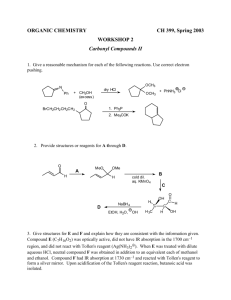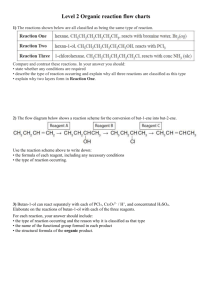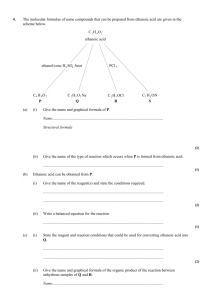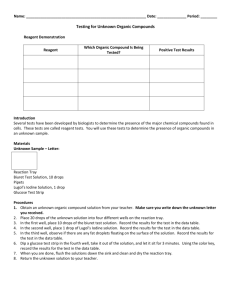2.9, 2.10. 2.11 test - A
advertisement
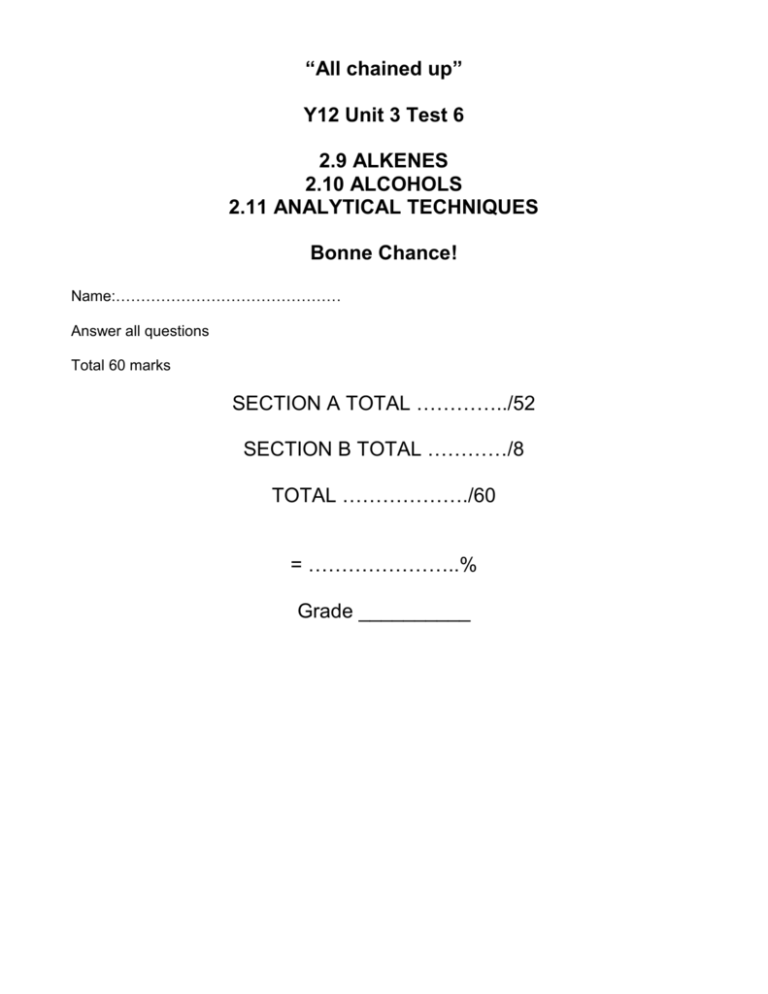
“All chained up” Y12 Unit 3 Test 6 2.9 ALKENES 2.10 ALCOHOLS 2.11 ANALYTICAL TECHNIQUES Bonne Chance! Name:……………………………………… Answer all questions Total 60 marks SECTION A TOTAL …………../52 SECTION B TOTAL …………/8 TOTAL ………………./60 = …………………..% Grade __________ SECTION A 1. Two stereoisomers of but-2-ene are formed when 2-bromobutane reacts with ethanolic potassium hydroxide. (i) Explain what is meant by the term stereoisomers. ........................................................................................................................... ........................................................................................................................... (ii) Draw the structures and give the names of the two stereoisomers of but-2-ene. Stereoisomer 1 Stereoisomer 2 Name ..................................................... Name .................................................... (iii) Name this type of stereoisomerism. ........................................................................................................................... (5) (Total 5 marks) 2. Propene reacts with bromine by a mechanism known as electrophilic addition. (a) Explain what is meant by the term electrophile and by the term addition. Electrophile ........................................................................................................... ................................................................................................................................ Addition ................................................................................................................. ................................................................................................................................ (2) (b) Explain why bromine, a non-polar molecule, is able to react with propene. ............................................................................................................................... ............................................................................................................................... ............................................................................................................................... (2) 1 (c) Outline the mechanism for the electrophilic addition of bromine to propene. Give the name of the product formed. Mechanism Name of product ..................................................................................................... (5) (d) The polymerisation of propene to form poly(propene) is an important industrial process. Name the type of polymerisation involved. ............................................................................................................................... (1) (Total 10 marks) 3. The reaction scheme below shows the conversion of compound A, 2-methylbut-1-ene, into compound B and then into compound C. CH3 CH 2 C CH 3 Step 1 CH 2 CH 3 A CH 3 concentrated H 2 SO 4 C CH 2 CH 3 OSO 2 OH CH 3 C CH 2 CH 3 OH B (a) CH 3 Step 2 C The structure of A is shown below. Circle those carbon atoms which must lie in the same plane. H H C C CH 3 CH 2 CH 3 (1) 2 (b) Outline a mechanism for the reaction in Step 1. (4) (c) State the reagent and condition used in Step 2. Name compound C. Reagent .................................................................................................................. Condition ................................................................................................................ Name of compound C .............................................................................................. (3) (d) When compound A is converted into compound C, a second alcohol, D, is also formed. Alcohol D is isomeric with C but is formed as a minor product. Identify alcohol D and explain why it is formed as the minor product. Identity of alcohol D ............................................................................................... Explanation ............................................................................................................. ................................................................................................................................ ................................................................................................................................ (3) (Total 11 marks) 4. Consider the following reaction schemes involving two alcohols, A and B, which are position isomers of each other. CH3CH2CH2CH2OH CH3CH2CH2CHO CH3CH2CH2COOH A butanal butanoic acid CH3CH2CH(OH)CH3 CH3CH2COCH3 B C (a) State what is meant by the term position isomers. ..................................................................................................................................... ..................................................................................................................................... ..................................................................................................................................... (2) 3 (b) Name compound A and compound C. Compound A ............................................................................................................... Compound C ............................................................................................................... (2) (c) Each of the reactions shown in the schemes above is of the same type and uses the same combination of reagents. (i) State the type of reaction. ........................................................................................…............................... (ii) Identify a suitable combination of reagents. ........................................................................................…............................... (iii) State how you would ensure that compound A is converted into butanoic acid rather than into butanal. ........................................................................................…............................... ........................................................................................…............................... (iv) Draw the structure of an isomer of compound A which does not react with this combination of reagents. (v) Draw the structure of the carboxylic acid formed by the reaction of methanol with this combination of reagents. (6) (d) (i) State a reagent which could be used to distinguish between butanal and compound C. ........................................................................................…............................... (ii) Draw the structure of another aldehyde which is an isomer of butanal. (2) (Total 12 marks) 4 5. Alcohol X has the structure (CH3)2 C(OH)CH(CH3)2 (i) Name alcohol X. ........................................................................................................................... (ii) Name the mechanism for the reaction occurring when alcohol X is converted into 2,3dimethylbut-2-ene in the presence of a strong acid. Name of mechanism............................................................................................. (iii) Give the structure of, and name an isomer of 2,3-dimethylbut-2-ene which is also formed in the reaction. Explain why two products are obtained. Structure Name of isomer................................................................................................. Explanation ...................................................................................................... ........................................................................................................................... ........................................................................................................................... (6) (Total 6marks) 6. Compounds C and D, shown below, are isomers of C5H10O H2 C H3C C CH2CH2CH3 H C H2C O C H2 C (a) H2C OH D Name compound C. .....................…………………………………………………………………………. (1) 5 (b) Use Table 2 on the Data Sheet to help you to answer this question. (i) Suggest the wavenumber of an absorption which is present in the infra-red spectrum of C but not in that of D. ...........…………………………………………………………………………. (ii) Suggest the wavenumber of an absorption which is present in the infra-red spectrum of D but not in that of C. ...........…………………………………………………………………………. (2) (c) Identify a reagent that you could use to distinguish between C and D. For each of C and D, state what you would observe when the compound is treated with this reagent. Reagent ……………………………..……………………………………………….. Observation with C ………………………………………………………………….. Observation with D ………………………………………………………………….. (3) (d) Compound E, CH3CH2CH2CH2CHO, is also an isomer of C5H10O Identify a reagent which will react with E but not with C or D. State what you would observe when E is treated with this reagent. Reagent ……………………………..……………………………………………….. Observation with E ………………………………………………………………….. (2) (Total 8 marks) 6 SECTION B 7. Ethanol is produced commercially by fermentation of aqueous glucose, C6H12O6 State two conditions, other than temperature, which are necessary for fermentation. Explain why neither a low temperature nor a high temperature is suitable for this reaction. Give two advantages of this method of production over that by the direct hydration of ethene. Write an equation for the production of ethanol by fermentation and an equation for the complete combustion of ethanol. (Total 8 marks) ……………………………………………………………………………………………………………. ……………………………………………………………………………………………………………. ……………………………………………………………………………………………………………. …………………………………………………………………………………………………………… ……………………………………………………………………………………………………………. ……………………………………………………………………………………………………………. ……………………………………………………………………………………………………………. ……………………………………………………………………………………………………………. ……………………………………………………………………………………………………………. ……………………………………………………………………………………………………………. ……………………………………………………………………………………………………………. ……………………………………………………………………………………………………………. ……………………………………………………………………………………………………………. ……………………………………………………………………………………………………………. ……………………………………………………………………………………………………………. ……………………………………………………………………………………………………………. ……………………………………………………………………………………………………………. ……………………………………………………………………………………………………………. ……………………………………………………………………………………………………………. ……………………………………………………………………………………………………………. 7


